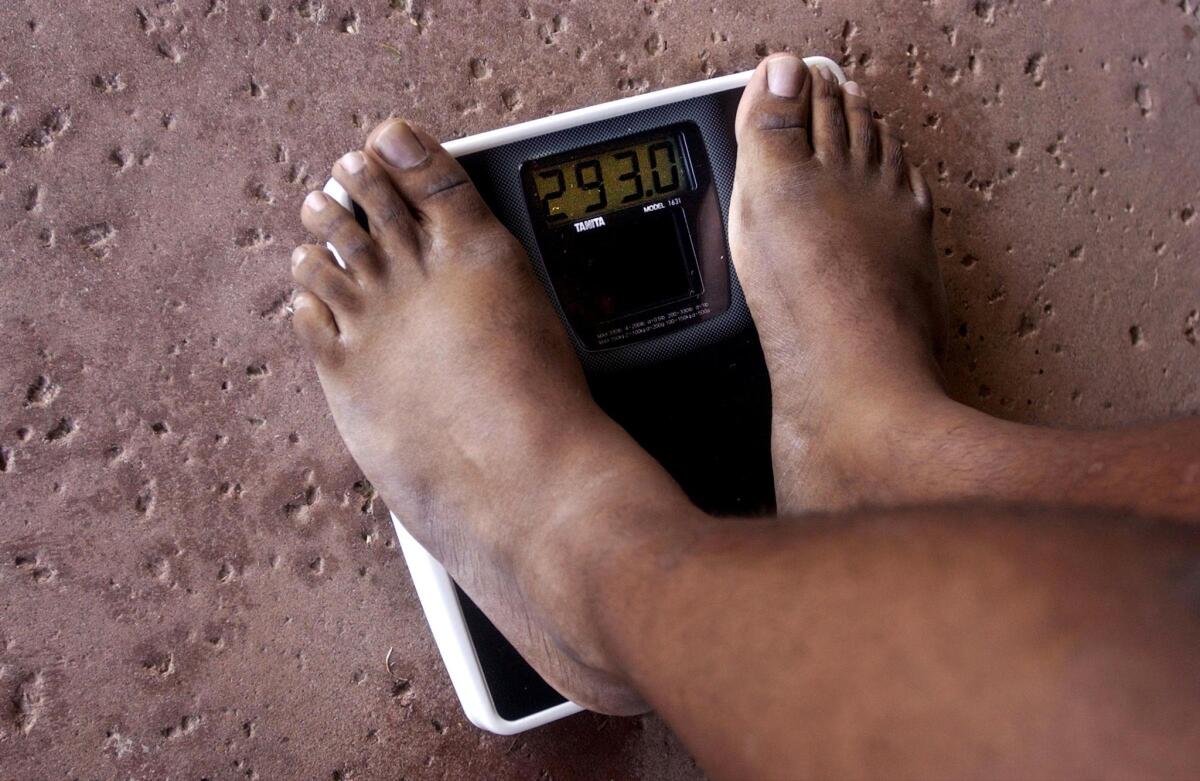Obesity is still a growing problem for American adults, CDC says

Nearly 38% of American adults were obese in 2013 and 2014, according to a new report from the Centers for Disease Control and Prevention.
America’s obesity problem just keeps getting bigger.
A new report from the Centers for Disease Control and Prevention says that 37.7% of U.S. adults were obese as of 2014. That’s up from 34.9% two years earlier.
From 2011 through 2014, an estimated 36.5% of Americans ages 20 and older had a body mass index of at least 30, putting them over the threshold for obesity. The prevalence was higher for women (38.3%) than for men (34.3%), the CDC data show.
For the most part, the older Americans got, the more likely they were to become obese. Younger adults in their 20s and 30s had a comparatively low rate of obesity — 32.3%. For middle-aged people in their 40s and 50s, that figure rose to 40.2%, then dropped slightly to 37% for older adults ages 60 and above. The difference between those last two age groups wasn’t statistically significant.
There were more disparities between racial and ethnic groups, according to the study. On the low end, only 11.7% of Asian American adults were classified as obese. At the other end of the spectrum, 48.1% of African Americans were obese. In between were Latinos (42.5% were obese) and whites (34.5% were obese).
Obesity in children is measured differently than in adults. To qualify, kids must have a body mass index that puts them at or above the 95th percentile for their age and gender based on the CDC’s growth charts from 2000.
Ideally, that would mean only 5% of the nation’s youth were obese. In reality, that figure was 17% in 2011-2014, according to the report. There was no real difference between boys (16.9%) and girls (17.1%).
The prevalence of childhood obesity increased markedly with age. Among children between the ages of 2 and 5, 8.9% were obese. The prevalence spiked to 17.5% for kids ages 6 to 11, then climbed to 20.5% for adolescents ages 12 to 19, the study said.
As with adults, the rate of obesity in kids varied significantly by race and ethnicity. Asian Americans still had the lowest prevalence, at 8.6%, followed by whites at 14.7%. After that the positions flipped, with 19.5% of African Americans and 21.9% of Latinos being classified as obese, according to the report.
Americans of all ages were more likely to be obese in 2013 and 2014 than they were in 1999 and 2000, the researchers found. The obesity rate among youth hit 17.1% in 2003 and 2004 and has remained essentially stable since then; in 2013 and 2014, it was 17.2%.
But for those ages 20 and older, things are still getting worse. In 1999 and 2000, 30.5% of adults were obese. That ticked up to 34.3% in 2005 and 2006 and 35.7% in 2009 and 2010 on the way to reaching 37.7% in 2013 and 2014, the most recent years for which data are available.
The way things are going, it’s hard to see how Americans can meet the federal government’s goal of reducing the nation’s adult obesity rate to 30.5% and the childhood obesity rate to 14.5% by the year 2020. The only group that’s below the Healthy People 2020 target is 2- to 5-year-olds; they’ll stay that way as long as their obesity rate doesn’t exceed 9.4%.
Obesity raises the risk of a host of health problems, including heart disease, type 2 diabetes, certain types of cancer, high blood pressure, stroke, osteoarthritis and reproductive problems. The heavier you get, the greater the risk that obesity will shorten your life: A 2014 study in PLOS Medicine calculated that people with a body mass index of 40 or above lost 6.5 years to 13.7 years of life as a result of obesity.
The new report was published Thursday by the CDC’s National Center for Health Statistics. The figures in the study came from data gathered by the National Health and Nutrition Examination Survey, an ongoing nationwide survey of American children and adults.
Follow me on Twitter @LATkarenkaplan and “like” Los Angeles Times Science & Health on Facebook.







